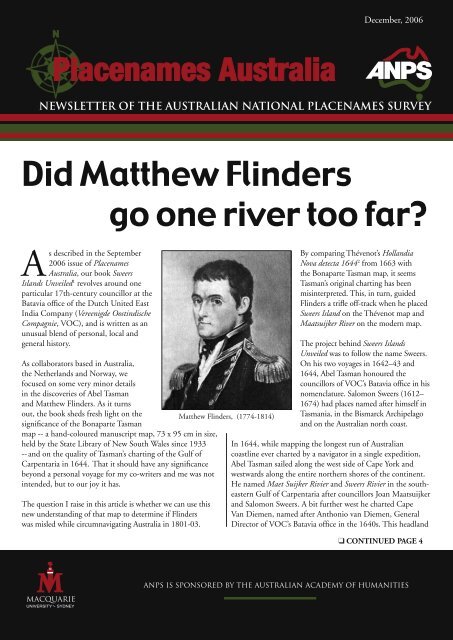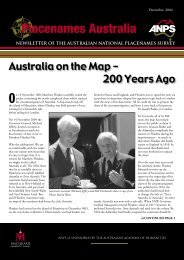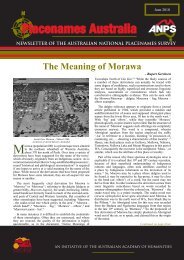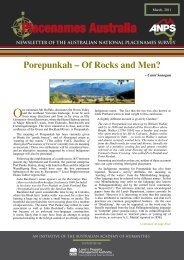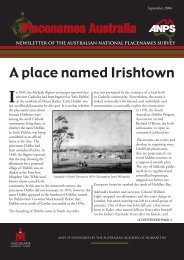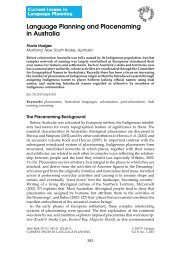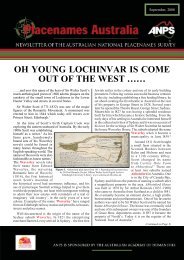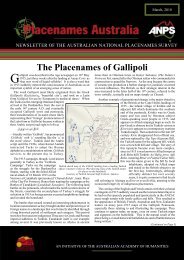Create successful ePaper yourself
Turn your PDF publications into a flip-book with our unique Google optimized e-Paper software.
Figure 1: Melchisedech Thévenot (1620–1692), Hollandia Nova detecta 1644, Terre Australe decouuerte l’an 1644. Engraving 50 x 37 cm.Printed by Jaques Langlois, Paris, 1663. (National Library of Australia, MAP NK 2785)CONTINUED FROM PAGE 1is easily recognized as present-day Wellesley Islands withMornington Island as the most significant landscape feature.Later, it was Matthew Flinders who gave the name SweersIsland to the easternmost island in the South Wellesley Group– a group that strangely enough was not recognized as islandsby Tasman.We must keep distinct these two places named after Sweers:the river named by Tasman in 1644 and the island namedby Flinders in 1802. We shall also keep an eye on R. MaetSuÿcker as it is called on the 1663 Thévenot map.Flinders’ nomenclatureWhen Flinders approached this area in 1802, he reportsthat he spotted a hill to the northwest as he sailed along theshallow coast, close to what we now know as the LeichhardtRiver 3 . With only the Thévenot map to back his decisionsand with no islands charted, he took the hill to be part of themainland and changed his course accordingly.The hill appeared to be the 29-metre Inspection Hill onSweers Island, and only the next day did Flinders realisethat they had come across a number of large islands notcharted earlier. When Flinders anchored between Sweersand Bentinck Islands while doing some necessary repairs onthe Investigator, he camped on Sweers Island for a fortnight.As it provided such good shelter, he named the strait theInvestigator Road, a name still in use today.Flinders soon also found that there was no Maatsuijker Riverwhere the old chart said there should be one. While chartingthe area, he tried to create a link between the old Thévenotmap and the modern one, and Flinders explains his theoriesin A voyage to Terra Australis (London 1814):The wide opening between this land [Sweers Island] and thelow coast to the southward [the mainland], I take to havebeen what is called Maatsuyker’s River in the old chart, andthat the island [Sweers Island], which Tasman, or whoevermade this examination, did not distinguish well from beingtoo far off, is the projecting point marked on the west side ofthe [Maatsuijker] river.
Thus, Flinders placed the old Maatsuijker River as the large,open sea between Sweers Island and the mainland, and hisnew Sweers Island as the small headland west of that ‘river’ onthe Thévenot map.Flinders’s reason for naming this island after VOC councillorSweers is rather complex. Most of the South Wellesley Islandshe named after Englishmen -- Bentinck after the Governorof Madras, William Bentinck; Allen Islands after a memberof his crew, etc. -- but the island on which he established ashore camp he reserved for the Dutch, as a tribute to thosewho had travelled there before him. His first thought wasto transfer the name Maatsuijker (or Maatsuyker, in Englishtranscription) from the river to the island, but since aMaatsuyker Group already existed in Van Diemens Land(Tasmania), explains Flinders, he chose Sweers instead. Weare not sure whether Flinders knew about the existence ofan old Sweers River in the area, but he certainly knew allthe old VOC councillors well from the literature he hadaccess to. There is no Sweers River on the Thévenot map’snomenclature.The Bonaparte Tasman mapThe Bonaparte Tasman map has its name from its one-timeowner Prince Roland Bonaparte, grandson of Napoleon’sbrother Lucien. Prince Roland purchased it from FrederickMüller in Holland in 1891, and the Prince’s daughter Marie,married to Prince George of Greece, gave it to the MitchellWing of the State Library of New South Wales in 1933.While there exist three complete journals of the 1642-43expedition, including the Mitchell Library’s copy and theso-called ‘Sailor’s Journal’, both once in Salomon Sweers’sownership, no journals of the 1644 expedition are known.This is why various 17th-century maps are the major sources ofinformation for this second voyage, and the Bonaparte Tasmanmap in particular. The route is laid down in great detail withsoundings and anchorages where they stopped for the night.Several other 17th-century maps include Tasman’s discoveries,but none in such detail.the map. Even more importantly, Anderson argues that hecan recognize the distinct handwriting of Isaac Gilsemanson the map. Gilsemans sailed with Tasman as supercargo,and without going into detail here, this piece of informationwould place the Bonaparte Tasman map as drawn in Batavia,in surroundings where it would seem very natural that itcould be made, no later than 1646 when Gilsemans died. Henever returned to the Netherlands.Tasman’s course around South WellesleyMany authors have tried to put Sweers and MaatsuijkerRivers on the modern map. They all tend to look to thevarious rivers and creeks that flow into the sea in the southeastern,inner part of the Gulf. Flinders, we recall, thoughtMaatsuijker was the open sea south of the South WellesleyGroup.We see it differently. Sweers Islands Unveiled has anexplanation of several pages that leads up to the conclusionbriefly presented here. We have looked at soundings andlandscape features on the Bonaparte Tasman map, we havestudied how Flinders approached the area in 1802, and wehave used local knowledge to try out all likely and unlikelypossibilities to pass the South Wellesley Group withoutcharting them as islands. Basically, our method was to putourselves mentally onboard Tasman’s ship, forgetting all weknew about modern maps in our attempt to see his worldthrough his eyes – and only later compare what we foundwith the real world.Figure 2: The outline of the Bonaparte Tasman map in the southeasternarea of the Gulf of Carpentaria, with old names and ourtheories on where to apply modern names. (Illustration by C.B.Høgenhoff, <strong>2006</strong>)The age of the map has been a matter of controversy. Whileit was believed in 1933 that it was an original map fromTasman’s time, a study performed in 1941 concluded that itis a copy, probably made around 1695 by an unknown Dutchcartographer. This conclusion has been commonly acceptedover the last 60 years, but is now in question.In this article and also in Sweers Islands Unveiled, I underlinethat the analysis we make deals only with some very fewoutlines in the Gulf of Carpentaria. The debate regardingthe age of the Bonaparte Tasman map goes into angles anddetails far beyond what is discussed here. However, a recentstudy by Grahame Anderson 4 concludes that the map wasnot drawn by one hand as indicated in the 1940s analysis,but that at least four people were involved in the making of
Figure 4 shows where Thévenot should have placed the tworivers, had he made (or been able to make) a better copy.But when we compare his map with the Bonaparte Tasmanmap, some important features are recognised – and the mapas such is really not such a bad reconstruction of the linesseen on Bonaparte Tasman. The most interesting part is thenorthwards stretching line on the east side of the headlandeast of Thévenot’s R. Maet Suÿcker. There is also a smallbay marked east of that again. These lines correspond verywell with the area between the Bonaparte Tasman map’sMaatsuijker River and Sweers River.And here we are: when Flinders made his conclusions, heplaced Sweers Island on the west side of R. Maet Suÿcker,whereas in fact it should have been on the east side. Andof course, Thévenot had placed the Maatsuijker where theSweers River should have been – and Flinders placed it inbetween Tasman’s two rivers.Figure 3: Detail of the Gulf of Carpentaria on the Thévenot map.Flinders used a copy of this map, and placed Sweers Island as ‘theprojecting point marked on the west side of the [Maatsuyker] river’.While Thévenot has included R. Maet Suÿcker, he has omittedSweers River and the area called Laegh lant (Low land) on theBonaparte Tasman map.Our conclusion is that Tasman’s Maatsuyker River isLeichhardt River or possibly Albert River. Here we agreewith many. Then, just like Flinders in 1802, we believe thatTasman saw Inspection Hill on Sweers Island and sailedtowards it. Seeing Sweers Island and Bentinck Island fromthe east, Tasman’s charters mistook the land they saw to bea northward-stretching coastline along the mainland. Thisparticular line on the Bonaparte Tasman map makes sense ifunderstood like this, and no sense if not. Then night came;the chart shows an anchorage that must be just north-eastof Sweers Island. The next day, seen from the north, theymistook Investigator Road for a river, and named it afterSweers. And from here on and westwards, a most interestingthing reveals itself: we can recognize basically the entirecoastline on the Bonaparte Tasman map. Along the northshores of Bentinck Island we follow the major curves towardsOak Tree Point; we can see the coastline turn south towardsAllen Island which is charted as a headland; and from therethe map continues in a curve marked as Laegh lant (Lowland) over to Mornington Island, or Cape Van Diemen on theold charts. The map and the land fit hand-in-glove.We shall make a note of one particular point here. Whilemany authors have attempted to place both Sweers andMaatsuyker River on the mainland, Flinders was on the righttrack. And Investigator Road, of course, might indeed beidentified both at Sweers River and Maatsuijker River. It justdepends on which map you use.Implications for the Bonaparte Tasman mapFigure 4: Detail from the Thévenot map, with Sweers River andMaatsuijker River applied where they should be placed if we usethe same logic as on the Bonaparte Tasman map. We can recognizethe general outline from Bonaparte Tasman. The coastline fromLeichhardt River to Sweers Island, stretching north, makes senseonly if one imagines that Tasman sailed towards Inspection Hill onSweers Island. (Illustration by C.B. Høgenhoff, <strong>2006</strong>)Back to FlindersFlinders had only the Thévenot map to guide him, withR. Maet Suÿcker shown as a large indentation or bay. Themere size of this ‘bay’ must have been what made him thinkit could be the open sea between Sweers Island and themainland. Consequently, it seemed only likely that SweersIsland was on the west side of that ‘bay’ 5 .
in 1941. Grahame Anderson sheds light on the map’s ageand origin, and when presented with a draft version of SweersIslands Unveiled in January this year, Mr. Paul Brunton,Senior Curator at the Mitchell Library in Sydney, saw theimplications our analysis had on the Bonaparte Tasmanmap. ‘It sheds fresh light on this map and its significanceand on the quality of the charting of that 1644 voyage’, hewrote in the foreword. Needless to say, for amateur historianslike Lyn and Tex Battle, Bob Forsyth, Annette Sweerts andmyself, having Paul Brunton write the foreword brought anunexpected dimension to our book. But despite this, thebook remains a personal tribute to Salomon Sweers, uncleand guardian of my ancestor Judith.Figure 5: Four 17 th -century maps superimposed. We see how theoutline of the 1645/46 Blaeu map is quite close to the BonaparteTasman map, while Thévenot (1663) and Visscher (1657) bothshow differences possibly brought on in the copying process overthe years. But like Thévenot, Blaeu had Maatsuijker River placedwhere Sweers River is on the Bonaparte Tasman map, and didnot include Sweers River. Visscher included both rivers in 1657.(Illustration by C.B. Høgenhoff, <strong>2006</strong>)The new information I mean to bring to the table now, ishow one can trace a ‘transfer of nomenclature’ from one riverto another, and how understanding the Bonaparte Tasmanmap can aid us in correcting Thévenot 1663 and Blaeu1645/46. If nothing else, this indicates that both artworkand nomenclature on the Bonaparte Tasman map is closer toTasman’s original charts. In a broader perspective, it might beyet another piece in the puzzle that will bring the BonaparteTasman map to the forefront of early Australian maps.And if Matthew Flinders should have sailed one river too farbecause of an incorrect copy made later in the 17th century,he still placed Sweers Island on the best possible spot: next toTasman’s Sweers River.Melchisedech Thévenot’s 1663 travel anthology wasimportant as it made Dutch discoveries up to 1644 knownto the wider public for the first time. The mapping of theAustralian continent on these 17th-century maps wouldremain unchanged and recognisable until the voyages ofCaptain James Cook more than a century later. There areof course other maps, among which Joan Blaeu’s ‘updated’world map published in Amsterdam in 1645/46 is theearliest. It includes Tasman’s then very recent discoveries, andcharts the areas discussed here basically as on the BonaparteTasman map, but without Sweers River. Yet other ones showa more or less twisted coastline in that same area, revealingsome degeneration in the copying process. We see this in theoutlines from the four maps I have super-imposed in Figure5 – the two debated here plus Blaeu’s 1645/46 map andNicolaas Visscher’s Indiæ Orientalis from Jan Janszoon’s NovusAtlas 1657/58. This article is not the place for a full ‘CapeVan Diemen and Sweers River’ comparison between variousmaps, but such an investigation would be interesting.The Bonaparte Tasman map was in unknown private handsbefore surfacing in 1860 when Jacob Swart published alithographic copy with transcribed, Latin lettering. Jan ErnstHeeres, the great biographer of Tasman’s life, was aware ofthe original Bonaparte Tasman map but had no access toit, and only since the 1930s has it been known to a wideraudience. A reproduction of the Swart version was laid out inmosaic on the stone floor in the Mitchell Library’s vestibuleCarsten Berg Høgenhoff, OsloNotes and references:1Carsten Berg Høgenhoff:, Sweers Islands Unveiled. Writtenin cooperation with Lyn & Tex Battle, Bob Forsyth andAnnette Sweerts. Published by Høgenhoff Forlag, Oslo,<strong>2006</strong>, ISBN 8299714028. See also http://siec.winnem.comand http://www.sweers.com.au.2Melchisedech Thévenot (1620–1692), Hollandia Novadetecta 1644, Terre Australe decouuerte l’an 1644. Engraving50 x 37 cm. Printed by Jaques Langlois, Paris, 1663.3Matthew Flinders, 1: A voyage to Terra Australis (twovolumes), G. & W. Nicol (London 1814). Reprinted bythe Libraries Board of South Australia, Australia FacsimileEditions # 37 (1966); 2: Journals of the Investigator 1801,1802 & 1803 (three volumes). First two volumes: www.sl.nsw.gov.au/flinders/manuscripts/3.html; third volume:Public Record Office, London.4Grahame Anderson, The Merchant of the Zeehaen: IsaacGilsemans and the Voyages of Abel Tasman, Te Papa Press(2001), ISBN 0909010757.5In Sweers Islands Unveiled, we refer to Flinders’understanding of the Thévenot map, but do not addressthe questions raised in this article. It was only after thebook had been printed that I saw that Thévenot must havehad the Maatsujker River placed in the wrong place.
The townshipsof Gordon andWallace, VicMuch of the feedback I have received from readersof my Lost and Almost Forgotten Towns of ColonialVictoria has been correspondence about whetheror not several townships described as ‘officially surveyed’were ever actually proclaimed in the Government Gazette.As an example of the complexities, I can furnish additionalinformation about the establishment of Gordon and Wallace,two nearby centres located in the Central Highlands region ofVictoria.According to Blake’s Place Names of Victoria (Rigby, 1977)the names of these settlements were derived from locallandholders: George Gordon, manager of Bungal pastoralrun in 1838, and presumably John Wallace who also gavehis name to Mount Wallace, over 15 miles to the south-eastof Gordon. However, it is my contention (and convictionin the case of Wallace) that the names came from an entirelydifferent source, and the following information demonstratesthis.and possibly the street theme for a new township would benominated by the Surveyor General’s Department. Afterthat, the actual street names would be left to the imaginationof the individual surveyor.By 1857, Charles George Gordon (1833-85, later GeneralGordon of China and Khartoum fame) had already receivedpopular acclaim for his deeds in the Crimean War, and thisappears to be the most likely source for the township name.The theme for the street names of Gordon was obviouslyiconic figures of history, and Wallace Street -- evidentlynamed after the Scottish patriot William Wallace (d. 1305)– forms the eastern boundary of land actually subdividedinto urban allotments. Wallace Street appears to be the onlyminor street actually constructed at the time of survey.Even though at the time little or no development took placein the surveyed township, the name Gordon was quicklyadopted for all of the area covered by diggings to the south,and soon a centre steadily developed around the location ofthe present township of Gordon. This is probably the reasonthat under the 1861 review, the official township of Gordonwas reproclaimed (probably in 1862) as the town of Wallace,with all the land within the town boundary designated as theparish of Wallace.About the same time, with the increasing importance ofGordon’s Diggings, the road was diverted through its centre,and this continued to be the main road to Ballarat until theCharles George Gordon (image from Wikipedia)Originally the area around present-day Gordon was referredto by the parish name of Kerrit Bareet, and then KangarooBob’s from the name of the first miner of note in the areaabout 1856. The first school in the area was opened in 1857as Hiscock’s New Find; Hiscock was acknowledged as thefinder of the first significant gold at Buninyong.Gordon was described as a gold-mining centre, but it doesnot rate a specific mention in Flett’s Gold Fields of Victoria,nor do there appear to have been many high-yielding minesin the area. I think that it would be fair to say that during itsmost important period, about 1860 to 1885, Gordon actedas a service provider to surrounding smaller centers, bothmining and agricultural. The mining warden (with goldminingregistry) was located at Gordon. This contrasts with(Mount) Egerton, three miles to the south, which, with itsmany deep lead mines, sustained a population of over 1,000persons for almost forty years from 1875.In 1857 a new and more direct road was opened betweenBallan and Ballarat, and it was planned that a township wouldbe surveyed along this road on the eastern side of the WestMoorabool River. In such cases, in contrast to the survey ofan existing named centre where most of the streets would benamed after notable local personalities at the time, the name
many of the undulations which are incurred even on today’sfreeway. However, the proposed route bypassed both BacchusMarsh and Ballan. There was a huge protest from thesecentres, and this partially explains why completion of theroute was delayed for nearly thirty years.Gordon railway station is located at the gap between thetownship and Mount Egerton, thus avoiding the hilly terrainin the vicinity of Gordon. Construction of a line fromWarenheip direct to Gordon would have been relativelysimple with almost even terrain and no topographicaldifficulties. However, by 1879 a well-developed farmingcommunity had come into existence along the Ballarat Road,and to capture this freight and passenger traffic the route tooka long northerly loop which added about 2-3 miles to thelength of the journey.Nevertheless the site of Gordon railway station still allowedfor the possibility of the line being continued along theoriginally projected southerly route if this was considereddesirable. This seems to be a nineteenth-century compromiseto ‘cover all bases’.Statue of William Wallace at Edinburgh Castleconstruction of the Western Freeway will over a hundredyears later.The parish map of 1875 shows that by that date the parishof Wallace had again become part of Kerrit Bareet while theactual area for the town of Wallace had been curtailed, i.e. thetown boundary now only encompassed the land originallysubdivided into numbered urban allotments. The same 1875parish map also shows the present Gordon as the village ofGordon. My best guess is that it was probably first officiallysurveyed in 1863 and given the name of Gordon’s.The 1952 plan shows that under the 1951 review Wallacewas reproclaimed as a township. However, the 1933 surveymap indicates only a couple of buildings within the reserveat that time. Under the same 1951 review, Gordon wasreproclaimed as the township of Gordon.Another aspect that also links Gordon and Wallace is thesignificance of the route for the railway from Warrenheip toGordon, completed in 1879.When the railway from Melbourne to Ballarat via Geelongwas completed in 1861, the citizens of Ballarat immediatelyclamoured for a direct link to Melbourne. Anticipating sucha request, railway engineers had already planned a routeseveral miles to the south of the road, which would avoidThe fact that the railway station was situated some distancefrom the township centre would not have assisted Gordonin its role as a service provider. During the next ten years itspopulation was almost halved – a rather unusual occurrencefollowing the opening of a railway line. However, it isprobably fair to say that this decline coincided with thereduction of goldmining activity in the immediate vicinity ofGordon in this period.On the other hand, with Wallace it was a considerablydifferent story. With the coming of the railway, a smallagricultural community which had established itself on thetown reserve about 1870 almost immediately relocated itselfto the vicinity of the Wallace railway station, almost two milesto the west. This new centre near the station grew rapidlyand its population peaked at around 300 persons about thebeginning of the First World War. For a large part of thetwentieth century the name Wallace was known throughoutVictoria and even beyond for the brand of butter produced infactories at Wallace and nearby.The final irony regarding the route of the railway occurredwhen the Fast Train Project was started in the year 2000. Bythis time all railway stations between Ballan and Ballarat hadbeen closed for more than twenty years, and it was suggestedthat the line should be rerouted direct from Gordon toWarrenhiep. If this had been implemented, the reductionby over two miles of the track length would certainly havereduced travel time and fuel costs, and eliminated severalwell-used level crossings. However, with the merest hint ofprotest from present landholders, this proposal was promptlyshelved.Angus R. Watson
Victoria's coastal placenamesWe have received an enquiry from Dr Eric Bird, editor of the encyclopedia The World's Coasts: Online, which has chaptersdescribing the geology and geomorphology of the coasts of each country and state. As part of a project to widen the scope ofthis work, Dr Bird has recently been preparing a list of the placenames on the coast of Victoria to be included in the section onthat state. He has been able to find origins for most of them, but has a list of unsolved items on which further information isneeded, and wonders if readers of Placenames Australia can help.The origins of the following names are unknown or obscure. Please send suggestions to ecfb@unimelb.edu.au.s Twelve Apostles (38º 42’ S, 143º 08’ E): originally Sowand Pigs (Piglets) islands, but when were they renamedand by whom?s Point Ronald (32º 42’ S, 143º 08’ E): who was Ronald?s Maudes Point (38º 45’ S, 143º 20’ E): shown onMurray’s 1877 map, but who was Maude, and when wasthis name applied?s Sutherland Beach (38º 45’ S, 143º 21’ E): shown onMurray’s 1877 map and probably named after a localsettler (who and when?).s Freetrader Point (38º 46’ S, 145º 14’ E): shown onMurray’s 1877 map. There may be a link with a shipcalled Freetrader, built in Hobart in 1850, and wreckedat the mouth of Hopkins River in 1894.s Campbell Cove (37º 57’ S, 144º 44’ E): possiblynamed after Captain Alexander Campbell, who wasHarbourmaster in Port Phillip in 1836.James Robertson Boag had a dairy and probably aguesthouse in Dromana in the 1870s (Janet South,Nepean Historical Society), but there is no evidence of alink between him or his family and this rocky headlandbeside Gunnamatta Beach.s Cobb Bluff (38º 27’ S, 145º 25’ E): It was shown asWatsons Bluff on an 1850 map, but who gave it thisname, when and why?s Leonard Point, Leonard Bay (39º 02’ S, 146º 18’ E): whowas Leonard, and when was this name applied?s St Margaret Island (38º 38’ S, 146º 50’ E): there is said tobe a link with St Margaret’s Bay west of Halifax in NovaScotia, but this is obscure (Blake 1977). It was knownby this name in the 1850s when W.E. and A.S. Laingheld it as a sheep run (Melva James, Yarram & DistrictHistorical Society), but what was its origin?s Dock Inlet (37º 47’ S, 148º 50’ E): there is no evidence ofa dock here, was it originally Duck Inlet or Dog Inlet?s Boag Rocks (38º 27’ S, 144º 51’ E): origin uncertain.10
Australiancommunitiesonline: usingplacenamesas communitydomain namesor corporations, in 2004 policy rules and guidelines weredeveloped by a broad range of stakeholders to provide thechecks and balances to ensure names are preserved specificallyfor community websites, for and run by the relevant localcommunity.In 2005 a not-for-profit company, .au Community Domains(auCD) was established to facilitate, develop and administratethe CGDNs. auCD provides support services tocommunities who want to register their geographic domainname for a community website portal and to processapplications based on the policy rules and guidelines.Australia has over 27,000 communities living in cities,towns and villages spread across a land mass similarin size to Europe. Many of these communities aregeographically isolated, far from major centers and services.One of the simplest uniting factors for any community isits name. The World-Wide Web offers an unprecedentedmeans of global communication and an opportunity forcommunities to interact in a cohesive manner.In a world first, the Australian Domain Name Administrator(auDA), the national regulator of the World-Wide Web,has created eight new geographic second-level domains(2LDs) to meet the needs of a body of users not well servedby the existing 2LDs. The aim is to provide an intuitive,standardised naming system to enable better access tolocal community, tourism and business information andto facilitate social and economic benefits to Australiancommunities.The new 2LDs represent each state and territory in Australia,and all community geographic domain names (CGDNs)will be registered as third-level domains (3LDs) in the simpleform of settlement dot jurisdiction dot au (e.g. katherine.nt.au).Their use will be restricted to community website portals thatreflect community interests such as local business, tourism,historical information, culture, sporting groups, local eventsand news. The purpose is to preserve Australian placenamesfor use by the relevant community.The genesis for this concept began in Bathurst, NSW, in2000 with a group of like-minded individuals who felt thatcommunities were not being given adequate opportunitiesto use the World-Wide Web. In addition, placenames, whilstreserved from registration in Australia, were increasinglybeing registered overseas to commercial interests.Following the fundamental principle that placenames belongto their respective communities and not to individualsOnly the names of addressable localities are available forregistration. These names basically cover all populated placesand are defined by the Committee for Geographical Namesin Australasia (CGNA), the authority on placenaming inAustralia and New Zealand. Addressable localities are definedas places where populations reside; these include towns,cities, suburbs and rural localities. Any disputes regarding thenames will be referred to the CGNA for consideration by theappropriate state or territory placenaming authority.The national launch of the Community Geographic DomainNames in the .au domain space took place on 8 August <strong>2006</strong>.Information on the system is available at www.aucd.org.auPaul HarcombeChief Surveyor, NSW Department of Lands &Board Member of auCD(first published in UNGEGN’s Information Bulletin No. 32)PS: Communities that have already established an onlinepresence under this scheme include Bathurst andWollongong in NSW, along with the Sydney suburbs ofGladesville and Hunters Hill, Ballarat and Koonawarrain Victoria, and Wyndham in Western Australia, withmore joining in all the time.11
Placenames puzzle no. 20PoetsAll the clues reveal placenames that arealso those of internationally famous poets(disregard spelling), e.g. (NSW/QLD) Hetemporarily mislaid Paradise … Milton1. (TAS) He urged us to pick the roses whilethere was time2. (TAS/NT) A poet who visited ruralcemeteries3. (TAS/NT) He was concerned about uselessacreages4. (QLD) He recounted that the harp was nolonger played in Tara’s halls5. (QLD/NSW) The middle name of the poetHopkins6. (QLD) He asked if it was three o’clock andtea time; lands surrounded by water7. (VIC) His name may be shown as 0.453kg;a small inlet on the coast8. (VIC) She assumed men were not attractedto women in spectacles; her street junction9. (VIC) He wrote a lot of nonsense; onetwelfth of the year10. (NT – former name) She wished she hadvisited the dentist more often; type ofmusic11. (ACT/NSW) He tells us that Andy hascrossed into Queensland with the cattle12. (SA) Not the Biblical doubting one; aircraft13. (SA) He bears the same name as a majorAustralian river; settlement14. (WA) Inflammatory (a man muchcelebrated by the Scots at Hogmanay);stretch of sand by the sea15. (WA/VIC) He addressed the skylark as ablithe spirit16. (NSW) She was not waving but drowningin her sheets of water17. (NSW) Wrote of a big cat apparently onfire in a nocturnal wood + -‘hurst’18. (NSW) His nickname came from that of aonce-popular guitar-type instrument19. (NSW) He described the Assyriancharging like a wolf attacking sheep;hound’s bark20. (NSW/QLD/SA/VIC) His lady, whoabandoned her weaving, had a name likean onion© Joyce Miles <strong>2006</strong>ContributionsContributions for Placenames Australia are welcome. Closing dates for submissions are:31 January for the March issue 31 July for the September issue30 April for the June issue 31 October for the <strong>December</strong> issue.Please send all contributions to the Editor, Flavia Hodges, at the address below.Electronic submissions are preferred, and photographic or other illustrations are greatlyappreciated.Mailing list and volunteer researchIf you’d like to receive the <strong>ANPS</strong> newsletter and/or receive informationabout how to become a Research Friend of the <strong>ANPS</strong>, please complete theform below and send by post or fax; or email the details to:<strong>ANPS</strong>Division of HumanitiesMacquarie UniversityNorth Ryde, SydneyNSW 2109Fax: (02) 9850 8240Email: Flavia.Hodges@humn.mq.edu.auName and/or organisation:…………………………………………….……………………………………………………………………………………………………………………………………………………Address:……………………………………………………………......……………………………………………………………....................Phone: …………………………….Fax:……………………………....Email: ………………………………………………………………….q Please add me to the newsletter mailing listq I wish to receive the newsletter by postq I wish to receive the newsletter by emailq Please send me information about becoming a Research Friendq Please remove me from the newsletter mailing listq Please note my change of address (new address above).Answers: 1. Herrick (To the Virgins, to Make Much of Time). 2. Gray (Elegy Written in a Country Churchyard). 3. Elliott (T.S.Eliot, The Waste Land). 4.Moore (The Harp that Once through Tara’s Halls). 5. Manly (Gerard Manley Hopkins). 6. Brook Islands (Rupert Brooke, The Old Vicarage, Grantchester).7. Pound Creek. 8. Parkers Corner (News Item). 9. Learmonth. 10. Ayers Rock (Pam Ayres, Oh, I Wish I’d Looked after me Teeth). 11. Lawson. 12.Thomas Plains. 13. Murray Town. 14. Burns Beach. 15. Shelley. 16. Smiths Lakes. 17. Blakehurst (The Tyger). 18. Paterson. 19. Byron Bay (TheDestruction of Sennacherib). 20. Tennyson (The Lady of Shallott).12


